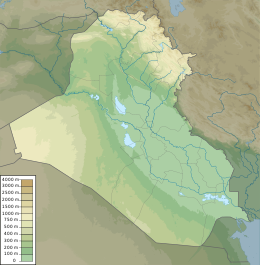
Back Halaf-beskawing Afrikaans ثقافة حلف Arabic Xalaf mədəniyyəti Azerbaijani Халафска култура Bulgarian Cultura d'Halaf Catalan Chaláfská kultura Czech Halafperioden Danish Halaf-Kultur German Cultura de Halaf Spanish Ḩalafi kultuur Estonian

Halaf culture (in green), next to Samarra, Hassuna and Ubaid cultures. | |
| Geographical range | Mesopotamia |
|---|---|
| Period | Neolithic 3 – Pottery Neolithic (PN) |
| Dates | c. 6,100–5,100 BC |
| Type site | Tell Halaf |
| Major sites | Tell Brak |
| Preceded by | Pre-Pottery Neolithic B, Yarmukian culture |
| Followed by | Halaf-Ubaid Transitional period, Hassuna culture, Samarra culture |
| The Neolithic |
|---|
| ↑ Mesolithic |
| ↓ Chalcolithic |
The Halaf culture is a prehistoric period which lasted between about 6100 BC and 5100 BC.[1] The period is a continuous development out of the earlier Pottery Neolithic and is located primarily in the fertile valley of the Khabur River (Nahr al-Khabur), of south-eastern Turkey, Syria, and northern Iraq, although Halaf-influenced material is found throughout Greater Mesopotamia.
While the period is named after the site of Tell Halaf in north Syria, excavated by Max von Oppenheim between 1911 and 1927, the earliest Halaf period material was excavated by John Garstang in 1908 at the site of Sakce Gözü.[2] Small amounts of Halaf material were also excavated in 1913 by Leonard Woolley at Carchemish, on the Turkish/Syrian border.[3] However, the most important site for the Halaf tradition was the site of Tell Arpachiyah, now located in the suburbs of Mosul, Iraq.[4]
The Halaf period was succeeded by the Halaf-Ubaid Transitional period, which comprised the late Halaf (c. 5400–5000 BC), and then by the Ubaid period.
- ^ Mario Liverani (2013). The Ancient Near East: History, Society and Economy. p. 48. ISBN 9781134750849.
- ^ Castro Gessner, G. 2011. "A Brief Overview of the Halaf Tradition" in Steadman, S and McMahon, G (eds.) The Oxford Handbook of Ancient anatolia. Oxford: Oxford University Press. p. 780
- ^ Castro Gessner, G. 2011. "A Brief Overview of the Halaf Tradition" in Steadman, S and McMahon, G (eds.) The Oxford Handbook of Ancient anatolia. Oxford: Oxford University Press. p. 781
- ^ Campbell, S. 2000. "The Burnt House at Arpachiyah: A Reexamination" Bulletin of the American Schools of Oriental Research no. 318. p. 1
